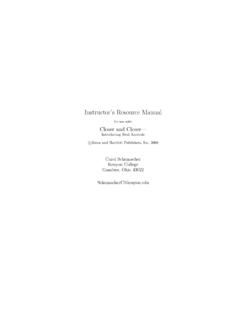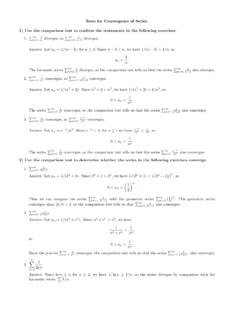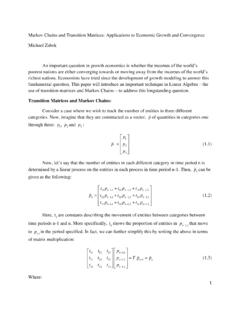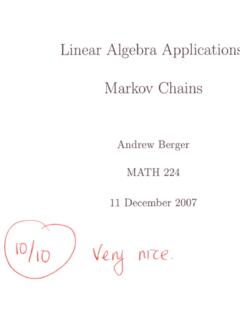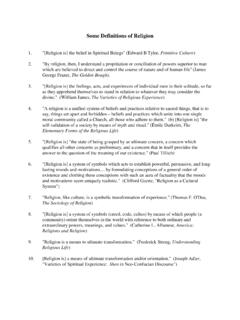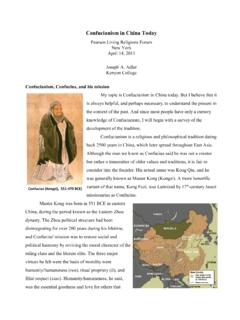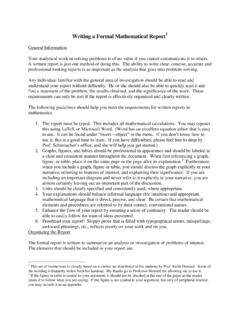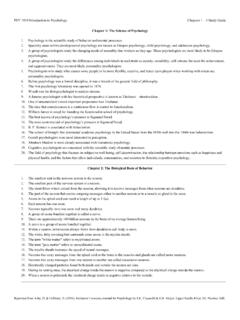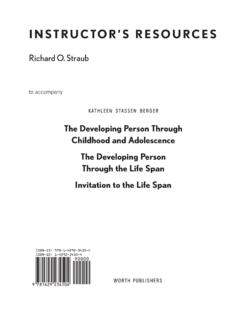Transcription of Instructor’s Resource Manual - kenyon.edu
1 instructor s Resource Manualfor use withChapter Zero Fundamental Notions of Abstract Mathematics, 2ec Addison-Wesley, 2001 Carol SchumacherKenyon CollegeGambier, Ohio 29, 2010 ContentsAbout This ManualvI A Course that usesChapter Zero1 Philosophy2 Goals .. 2 Learning a language .. 3 Student Autonomy .. 3 Class Mechanics5 Class Organization .. 5 Student Responsibilities .. 5 Class Presentations .. 6 Cooperative Learning .. 7My Role .. 8 Two Typical Class Meetings .. 9 Testing and Grades .. 11 Strategies14 The First Few Class Periods .. 14 Why I Don t Lecture .. 14 New Habits, New Routines .. 15 Allaying Students Fears .. 17 What About the Obvious ? .. 18 Common Traps and Problems .. 18 How Much Do I Tell Them? .. 19 How Do We Think About This? .. 19 Too Many Symbols, Not Enough Words .. 20 Winging it.
2 22 Putting Off the Inevitable .. 22 Passive Student Syndrome .. 23 Who is he talking to,really? .. 24 Misplaced student solidarity .. 25 Becalmed .. 26 Group Work .. 27 How I Constitute the Groups .. 27 How I Assign Work to the Groups .. 27 Class Logistics .. 28 Results29II Chapter by Chapter30 Chapter 0 Introductory Essay30 Saving Time .. 30 Chapter 1 Logic30 Tips for Reinforcing Logic in Later Work .. 33 Chapter 2 Sets34 The Rough Spots .. 35 Chapter 3 Induction36 Chapter 4 Relations36 Section Relations .. 37 Section Orderings .. 37 Section Equivalence Relations .. 39 Section Graphs .. 40 Chapter 5 Functions40 Section Basic Ideas .. 40 Sections and Inverses, Images and Inverse Images .. 41 The Rough Spots .. 42 Section Order Isomorphisms .. 43 Section Sequences .. 43 Section Binary Operations.
3 44 Chapter 6 Elementary Number Theory44 Saving Time .. 45 Chapter 7 Cardinality45 Sections and Galileo s Paradox and Infinite Sets .. 45 Sections and Countable and Uncountable Sets .. 46 The Rough Spots .. 46 Sections and Comparing Cardinalities .. 47 Chapter 8 The Real Numbers48 Sections through The Axioms .. 48 Section Sequence Convergence .. 49 The Appendices49 III Technical Details50 Elaborations on the Dependency Chart50 Skipping Partial Orderings .. 50 Skipping Sequences .. 50 Cardinality a Small Caution .. 51 Errata51 About This ManualDear Colleague:My intention is that this be a very down-to-earth, practical guide to helpyou when you useChapter Zeroin the Zerois written insuch a way that its ultimate worth as a learning tool depends a great deal onthe way that students interact with it, with each other, and with you.
4 Thedynamics of each individual course strongly influences how successful the textwill be. Therefore, I write this guide almost entirely from the point of view ofa teacher who has usedChapter Zeroin a class and only occasionally from thepoint of view of the have used the first edition ofChapter Zeroin my own classes for a numberof years. I also received detailed feedback from reviewers that had used thefirst edition in their classes. With this information in hand, I have made anumber of (what I think are) improvements in the second edition. I hope thatthese changes will make things run more smoothly for instructors includingme that use the instructor s Resource guide is divided into two major parts. In the firstpart, I will speak in detail about the way that I organize and run the class whenI useChapter Zero. I will also discuss specific difficulties that I have encounteredand suggest strategies for heading them off or dealing with them if they arise.
5 (There are a few additions from the first edition of the IRM, but it is largelythe same as the corresponding section in the first edition.)The discussion in the first part will concentrate on the particular modelthat I have used for running the class: a seminar-like model in which thereis virtually no lecturing. Class time is spent in discussion, small group work,and with students presenting their proofs and solutions to one another. Theinstructor acts primarily as a moderator. It makes sense to think of this as the native model for using the book;Chapter Zerowas written precisely for usein this way. However, it is not at all difficult to see ways of including morelecturing, and you may choose to do so. Even if you do things in a way verydifferent from mine, some of my comments may be useful to you; so I urge youat least to skim the first the second part, I will go through the book chapter by chapter and makespecific comments.
6 I will do as many of the following as seem useful: Tell you what I do when I cover the chapter. Point out specific places where my students have encountered difficulties(and ways that I have found of helping them through). Talk about overall strategies I have used to make the chapter go Make suggestions for class the end of the second part, I include a section elaborating on the de-pendency chart that appears in the front matter toChapter Zero, as well as alist of the errors that I have found in the book. As I become aware of othererrors, I will update this section in the web-version of the IRM. Known errorswill be corrected for the second and subsequent printings. If you find any errors,I would consider it a great kindness were you to let me know about understand that what you find herein are thoughts based on my ownexperiences teaching out ofChapter Zero.
7 I am continually learning new thingsas I teach, and therefore I have no pretensions that what I write is the definitiveor final word. I hope that many of my comments will be useful to you. Thereis no doubt that some of them will not be. If, in using the book, you encounterdifficulties that I do not address in this guide , I hope that you will feel freeto contact me. I will try to help if I can. Better yet, if you find additionalstrategies that work in your classes or for your students, I would be grateful ifyou would let me know of them. That way I can use them myself and pass themon to other colleagues who are using the ,Carol S. SchumacherviPart IA Course that usesChapter ZeroThis chapter describes how I have usedChapter Zeroin a sophomore-level courseat Kenyon College. I include fairly detailed descriptions of the day-to-day rou-tine of the class, various problems and pitfalls I have encountered, and my gen-eral strategies for dealing with them.
8 The course is typically taken by studentswho have had three semesters of calculus (though no knowledge of calculus isassumed by the text), and is a prerequisite for our upper-level courses in ab-stract algebra, real analysis, etc. Each year a number of our best prepared andmost mathematically inclined first-year students take the course. They tend todo very well, often outperforming the sophomores. Recently, almost half of thestudents have been first-year students. For the purposes of this discussion, Iwill call the course Foundations. Remark: TheNote to the Studentfound in the front matter ofChapter Zerocontains essential information about the way that students are meant to use thetext and about the meanings of various labels that are used through out thebook. It is a must read for teachers as well as students who use the root, my goal in Foundations is quite simple.
9 Students who complete thecourse should be well-prepared to succeed in more advanced studies of abstractmathematics. This means that they must have acquired certain skills: They should know how to make sense of an abstract definition by analyzingit carefully and constructing examples. They should also know how to make sense of a mathematical statement,and be able to bring to bear a variety of strategies for constructing itsproof. They must be able to recognize a rigorous proof when they read , they need to be able to pick out the weak spot(s) in a lessrigorous argument their own or someone else s. They ought to be able to fill in details in a sketchy proof. Once they have devised a proof, they must be able to write it down in aclear, concise manner using correct English and mathematical grammar. Students have to be able to present and defend a proof to a group of theirpeers oral communication is as important as written , I hope that they will think of these as central tools in the mathe-matical enterprise.
10 (In reality, of course, these are very sophisticated skills, sostudents who finishFoundationsare only beginning to fully acquire these skills;theFoundationscourse is a first step, but a very important one.)However, students need more than an array of desirable skills. They alsoneed some core knowledge to work from. Thus, one of my aims in the Foun-dations course is for my students to acquire a thorough-going mastery of somefundamental topics. The topics inChapter Zerounderlie and permeate virtuallyall branches of mathematics, and students will see them over and over again intheir further a LanguageI often think of Foundations as a language course. Learning mathematicallanguage goes beyond just learning jargon (though there is plenty of vocabu-lary to acquire). Mathematical language is far more precise than ordinary waysof speaking and writing, and using language so precisely does not come natu-rally to most people.
